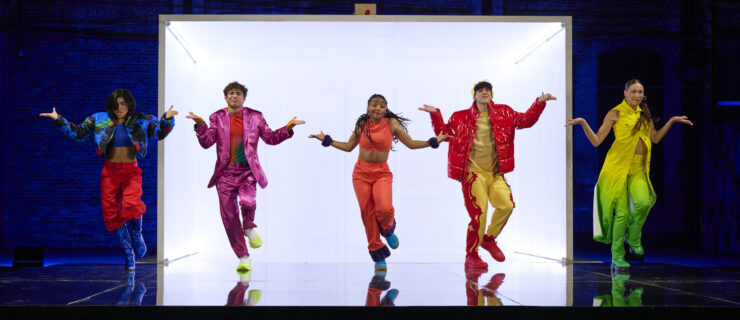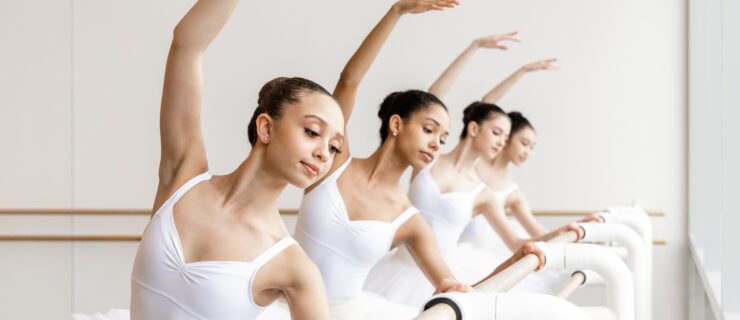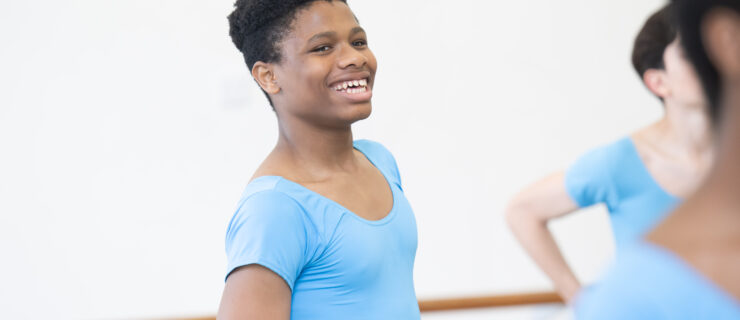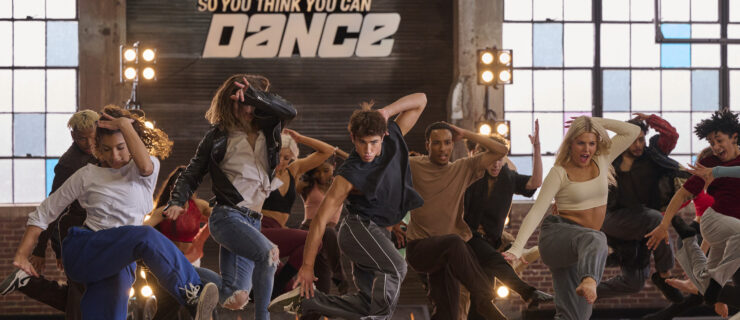The Stephen Petronio Company
For the past 22 years, with one hand on the pulse of pop culture and the other bent toward fast, aggressive movement, Stephen Petronio has been challenging audiences with dance that is filled with more slicing, slashing and piercing than the understatement of the artistic minimalist period during which he came of age. “I can remember sitting around with the generation before me and listening to people talk about color and cut and line, and nobody would ever talk about subjects,” he says. “I see dance as animalistic and sexy and embroiling and boiling, and those are the things that were interesting to me.”
For anyone who’s seen Petronio’s work, it’s clear that he has since thoroughly explored these interests. Stephen Petronio Company dancers are as fierce and luscious as the movement is aggressive and physical. “I make very intricate movements first, and then I build the piece out of that language,” says Petronio. “That’s the reason why I think my pieces are different. The language is idiosyncratic and original.”
Petronio began honing his style in 1984, when he started SPC (he had been dancing with the Trisha Brown Company for five years, where he was the first male member of her group), and quickly became known as a troublemaker within the dance community, both for being outspoken—SPC grew up alongside the AIDS crisis, and Petronio used his success as a platform for activism—as well as for the way he constructed dances. “I would create a central architectural theme, and then I would build things around that architectural theme,” he explains. “Then I would remove that central architecture, so all you saw were the [moves] that were built, but no order existed. For me that was very pleasurable. I also liked the idea of a structure that was falling apart—more decomposition than composition.” Now, he admits, “I am more generous about letting the audience recognize what’s happening onstage.”
Even so, his signature look is still a constant stream of movement. It took time to develop, though, because for years he thought it was a shortcoming. “Somebody once told me that when I dance, it was like turning on a faucet that wouldn’t stop. At first I was hurt, and then I realized [it] was my special talent so I developed that talent—and then I went on to learn to vary [the quality].” According to SPC member Gino Grenek, Petronio uses the same philosophy when nurturing his dancers: “Stephen has a wonderful ability to take what you can give as a dancer to the next level. Things that you are very comfortable with, he’ll take and push you further in.”
The Birth of New Work
Petronio’s newest works will premiere in April, at NYC’s Joyce Theater. BLOOM and Bud Suite are both set to the music of singer/songwriter Rufus Wainwright, whose melodic, mournful voice may seem like an unnatural match to Petronio’s angular, jagged movements, yet they mesh like a good book and a stormy day.
This season is consciously relatively light in subject matter, something the company’s due for, considering the last few dances Petronio has added to the repertory were made in post–9/11 NYC, and were, in his words, “dark, disjointed pieces.” The Island of Misfit Toys, for example, choreographed in 2003, was set to the recorded music of Lou Reed from The Velvet Underground, the influential psychedelic rock band of the late 1960s, and incorporated giant sets depicting babies with scooped-out faces and a recording of Edgar Allan Poe’s “The Raven,” read by character actor Willem Dafoe.
Misfit
set a somber mood, but it also facilitated the partnership between Wainwright and Petronio. One of the songs in Misfit was Reed’s Balloon, sung by Wainwright’s mom, Kate McGarrigle and her sister Anna. “When I realized that was Rufus’ mother, I called Rufus and said ‘your mother is singing one of Lou Reed’s songs in my show, and I’d love for you to come and see it,’” Petronio recalls. At the after party, he asked Wainwright if he’d like to collaborate.
Creative Synergy
Armed with the titles Bud and BLOOM—Petronio always has a title before choreographing—he started the collaboration process by explaining what the words mean to him. “Bud is interested in partnerships: physical partnerships, female duets, male duets, female quartets, groups, chaotic relationships, and I gave the dance the name because it’s a guy thing—buddy, bud, buddy-slash-relationship. But I also wanted Bud to be the germ, the germination point for BLOOM.”
He didn’t cast himself, because the work is a celebration of “going from something with potential to something that’s full,” says Petronio, 50, who often performs with the company. “I want it to [exhibit] popping youth—that irrepressible stage of your life,” he says. “I don’t really see someone at the stage of my life inherent to that portrayal.” Perhaps Wainwright’s youth—at 33, he’s the same age as the oldest members of the company—is in part what made him an attractive partner for this project.
Set with how the collaboration would play out, the two still needed common ground, especially since Wainwright had never before composed for dance. They soon found a mutual affinity for language. “Words are really important to me,” says Petronio. “Although [my] work is not a narrative, words inform how I work and how I think about the work.”
The two artists eventually agreed on using Walt Whitman’s “Unseen Buds” and “One’s-Self I Sing” verbatim, as lyrics for Bud Suite. Wainwright also incorporated the Lux Aeterna, or light eternal, a Catholic mass sung in Latin. “Whitman’s structure is akin to the type of movement I make,” says Petronio. “It held [the choreography] very nicely. It was like a canvas I could paint on, and the Latin was gorgeous and reverential, but also didn’t limit me in terms of having to illustrate the meaning, ’cause who understands Latin?” The choral score will be performed live by the Young People’s Chorus of New York. The score for BLOOM comprises four songs that have been released before on various albums.
A Split Bill
If the first half of the evening belongs to Wainwright, the second belongs to Stravinsky. Petronio’s version of The Rite of Spring, which he choreographed in 1992, is set to the famous Stravinsky score. This work, titled The Rite Part, will be a restaging of the original 35-minute piece, titled Full Half Wrong, and is largely about empowerment. The stage of his life when the piece was created, Petronio says, was sympathetic to the anger with which Stravinsky composed the music, and complements BLOOM and Bud Suite. “Stravinsky just banged [the piano] like a drum at some points. I felt there was something violent about that,” Petronio says. “And the whole spring cycle is a viscously violent thing—a kind of unstoppable urge to push through the ground.”
Stravinsky’s version also brought pagan themes to the art world. “That was kind of the birth of modernism,” says Petronio, “and that pagan notion of the community choosing a virgin and sacrificing her to the gods of fertility, so that the crops could grow, I thought was radical in that time and horrifying in this time.” Petronio was also intrigued by the fact that modern people would refer to the original ballet without talking about how sexist it is. The Rite Part, which he calls the anti-sacrifice, is his response to that sexism. His virgin, played by Shila Tirabassi, is “aggressive and empowered, not trembling and waiting to get into King Kong’s hands,” he says.
Choreographic Responsibility
Petronio’s choreographic style could also be described as aggressive and empowered. “I love the fact that [when performing any of his works] there’s not a guarantee that when you start the show you’re going to be standing when it’s all over,” says Grenek. “Some of my best performances have been the ones where I’ve fallen flat on my face, because I’ve just really gone for it—and the work requires that. If you kind of do it halfway, there’s no point. You might as well stay home.”
Early in his career, Petronio chose to create alone in the studio, but now describes dance-making as a social job. “I’ll walk into the [process] and often have an idea,” he explains, “but rarely a specific move. Generally it’s about what’s going to happen in the studio that day.” To make the method work, Petronio surrounds himself with technically trained dancers who aren’t afraid to take risks.
For the dancers, the most exciting part about working with Petronio is that he creates an environment in which they’re expected to take risks. Dancer Amanda Wells says the coolest and most challenging part of dancing with SPC is that “Stephen allows us to have freedom within a structure, so it challenges us to go beyond what we’re used to. It’s easy to slip into something fancy or pretty, but he wants us to do something that’s different, interesting and individualistic,” she says.
If you’re the type of dancer who needs to be told what to do, you’re not right for this company. Petronio gives the dancers a great deal of voice when it comes to the choreography, though it’s not about listening to what they have to say as much as it’s about engaging them creatively. “I’ll show them something or say something and they’ll have a response, and that may or may not become the choreography,” he explains. “But when the actual steps are made, I make steps and sew them into phrases.”
He will then often give the dancers tasks to accomplish, such as asking one dancer to do just the arms of the phrase and another dancer to do just the legs, or asking them to do the entire phrase while moving backwards as if the floor were crumbling. Out of this exploration he finds what he wants, and though he encourages the dancers, it’s challenging when they “begin slamming alternative information at me to see if I want it,” he says. “Sometimes it gets to a point where I have to repress them, and it’s a delicate balance, because you never know when somebody will do something fabulous or accidental that you’re going to love…. I really value unconscious finds in composition.” When dancer Shila Tirabassi first joined the company, she was struck by the fact that he trusted his dancers so much. “He would put something out there and then allow each dancer to do it [her] own unique way,” she says. “My previous experience was trying to fit a mold.”
Something to Communicate
Individualism is the cornerstone of SPC, and even though Petronio’s work is rarely narrative, his dancers must say something unique through their movement. “I like people to have incredibly strong technique, which frees their soul,” he says. “I mean, that’s what I look for—people who have something to dance about.” They also have to be virtuosic without being overstated. “I think of it like an amazing tailored suit, without understanding why it’s well tailored. If you can tell they’re virtuosos then you might as well be at the circus.” Wells, for instance, has incredible facility, explains Petronio, but in previous years, there was something missing. “Just this year she’s doing the same movement, but now she’s dancing about something, and that I find thrilling—dancers have a voice and it’s coming from some deep, unconscious place.”
When asked about her awakening, Wells says that the making of Bud has helped her come into her own, partly because two of SPC’s senior members left the company before the creative process. “We’ve all unified to make this piece,” she says. “And I walked into this process with [more] confidence. I’m feeling more and more comfortable in my own skin. I trust myself more, and I’ve always trusted Stephen.”
The challenge to harness their individual voices is acute for the dancers, since the movement is so detailed. “There’s very fast work; it’s very complicated work and it’s very technical work,” says Grenek. “If you start thinking about all of those elements, you’re stuck before you even begin.” For some, like Davalois Fearon, getting the movement meant changing the way she looked at choreography. “I have to go deeper in order to understand exactly what I’m doing—not just seeing [the movement] on the surface, but seeing the motivation [behind] the movement,” she says.
Understanding the motivation is half the battle. Getting the tricky choreography also takes an understanding of how each sequence travels through the body. According to dancer Jonathan Jaffe, a movement may “start from your fingertips and go through your shoulder and spiral and twist and come out your trochanter.” Plus, there could be multiple sequences going on at the same time. In order to handle the physical demands of Petronio’s style, Tirabassi says, “you have to keep your body and your mind in absolute tip-top shape. If you let anything, like your sleep [schedule], slide, then it could lead to a breakdown or an injury.”
A Member of the Company
SPC doesn’t have formal dancer contracts, but rather verbal agreements to stay with the company for at least two years. It takes at least one year for a dancer to get good at the movement, says Petronio, after which he wants a year of that dancer looking good. Attending an audition or a workshop is the best way to try to get into the company. “Sending your resumé blindly doesn’t work for me. E-mailing me blindly doesn’t work for me,” Petronio says. “There are so many things in the day, and that doesn’t get any attention.”
Perhaps the most important expectation of Petronio’s dancers is that the company be their first priority. “This is a big bone of contention,” Petronio admits. “Everything else, including making your real living—because this is not enough money to live on—your school and your love affairs and all that stuff happens around me. I am your first thought and your first commitment.”
Petronio is demanding, but not disrespectful. The company is a tight, well-oiled machine kept together by a mixture of passion, trust and mutual admiration. “I’m surrounded by talented, intelligent, risk-taking people and that’s an amazing part of my job,” says Wells. For newer members, like Jaffe, the camaraderie among the members is crucial. “I really, really love the movement but I [also] really admire my fellow dancers,” he explains.
Dancer Elena Demyanenko is driven by something else—the opportunity to find her own interpretation of Petronio’s vision: “I like to think that the time when dancers are only expressing the personalities of their choreographers, by memorizing a language that is superimposed on their bodies, is not as dominant anymore,” she says.



